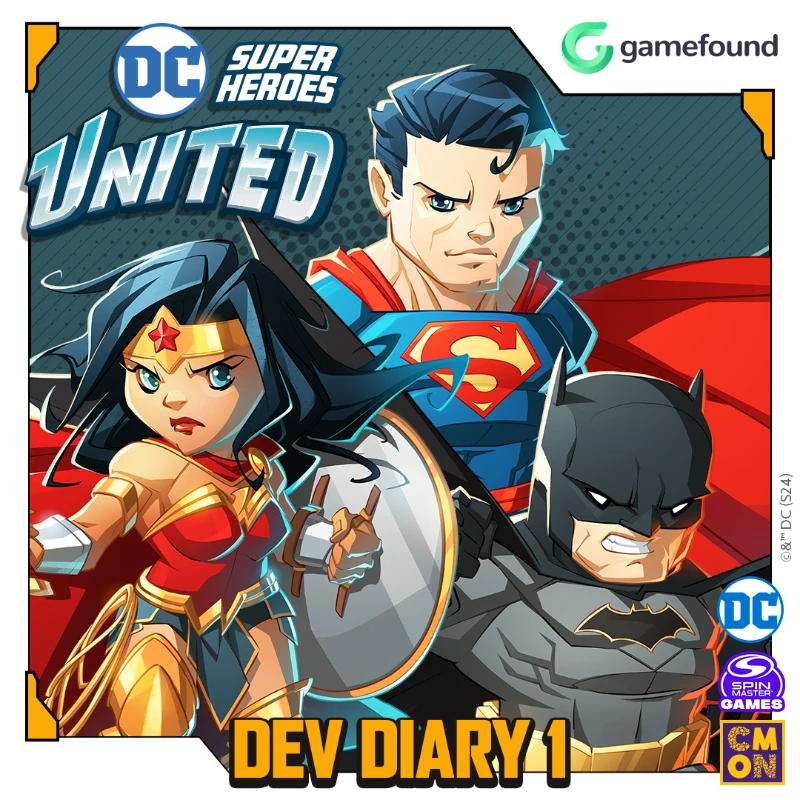
Andrea Chiarvesio, the lead designer for the highly anticipated game DC Super Heroes United, recently shared exclusive insights into the core box design and some of its prominent heroes and villains. This marks a significant moment for fans eagerly awaiting the game, as Chiarvesio delves into the creative process and the unique mechanics that bring these iconic characters to life.
Check out our review of Marvel United Here
A Journey from Theory to Reality
The conceptualization of “DC Super Heroes United” began a couple of years ago, when it was uncertain whether the United system could be effectively applied to the DC universe or any other franchise. Chiarvesio reflects on this journey, expressing his excitement about revisiting the project once it was confirmed for release. The core box design played a seminal role in shaping other United designs, establishing a foundational framework for the game.
The Caped Crusader: Batman
Batman, the first hero Chiarvesio wanted to design, embodies the quintessential qualities of the Caped Crusader. Translating Batman’s extensive arsenal of gadgets into special actions was a challenging yet rewarding task. This led to the birth of the Equipment mechanic, a vital aspect of Batman’s gameplay. Players must choose from a range of gadgets, such as batarangs and grapple guns, to counter the villain’s plans. Batman’s martial arts skills, detective prowess, and indomitable will are also reflected in his special actions, making him an excellent choice for the solo Commander mode.
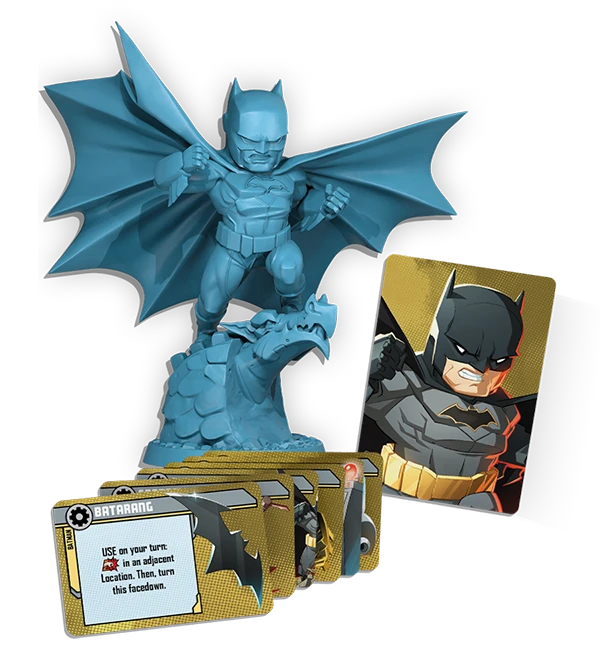
Bruce Wayne’s dual identity is a critical component of Batman’s character. As the world’s greatest detective, his analytical skills are second to none. This analytical prowess is mirrored in the gameplay, where players must anticipate the villain’s moves and prepare accordingly. The strategic depth provided by Batman’s gadgets and skills ensures a rewarding experience for players who enjoy methodical planning and tactical combat.
The Man of Steel: Superman
Superman, or Kal-El, contrasts sharply with Batman. As the Man of Steel, Superman’s invulnerability and Kryptonian physiology grant him incredible powers, including flight, heat vision, and super breath. Unlike Batman, Superman does not rely on equipment. Instead, players face strategic decisions about using his powers for damage protection or mobility. Superman’s gameplay captures the essence of being an unstoppable hero, particularly at higher player counts.
The strategic choices involved in playing Superman revolve around balancing his immense power with his inherent vulnerabilities. Players must decide whether to focus on offense or defense, depending on the situation. Superman’s gameplay is designed to make players feel like they are embodying the hero, with decisions that reflect his iconic status and the moral dilemmas he often faces.
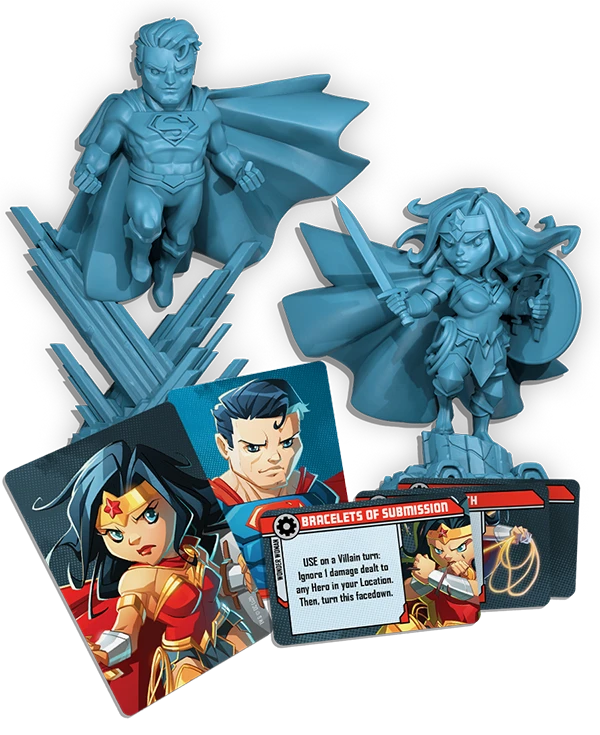
The Amazon Princess: Wonder Woman
Wonder Woman, the Princess of Themyscira, is perhaps the most versatile hero in the core set. Her equipment offers protection, movement, and reconnaissance abilities, complemented by her special powers. Diana excels at resolving threats, making her a popular choice at any player count. Chiarvesio even considered giving her a skateboard as a nod to the 1970s TV series, but this idea was ultimately shelved, though it might resurface as a promotional item in the future.
Diana’s gameplay reflects her multifaceted nature as a warrior, diplomat, and protector. Her equipment, such as the Lasso of Truth and her indestructible bracelets, provide a range of tactical options. Wonder Woman’s abilities to inspire and support other heroes make her an invaluable team member. She is especially effective against new villains, providing a reliable choice for players unfamiliar with the specific threats they face.
The Fastest Man Alive: The Flash
Designing The Flash posed a unique challenge. As the fastest man alive and a master of the Speed Force, Barry Allen’s powers needed to be balanced within the United system. After months of experimentation, Chiarvesio and his team developed a gameplay mechanic that allows The Flash to dominate the board with reach and flexibility. By tapping into his Speed Force Conduit, The Flash can perform high-action turns, though he must build momentum by drawing and playing the right cards.
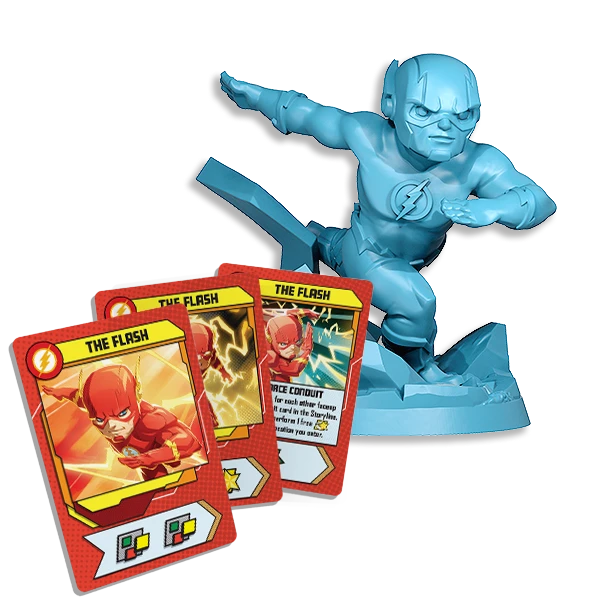
The Flash’s gameplay is characterized by rapid movement and high-energy actions. His ability to traverse the board quickly and perform multiple actions in a single turn provides a dynamic and exciting playstyle. However, players must manage his momentum carefully, balancing his speed with the need to build up his power. The Flash’s design captures the thrill of his superhuman abilities while maintaining strategic depth.
The Mastermind: Lex Luthor
Turning to the villains, Lex Luthor stands out as a formidable antagonist. Known for his genius-level intellect and complex schemes, Luthor often poses as a hero to achieve his long-term goals. In “DC Super Heroes United,” Luthor’s gameplay involves summoning the Legion of Doom and pretending to help the heroes complete their missions. If he successfully fills any of the hero missions, he wins the game by appearing as a hero. Even when his true intentions are revealed, Luthor’s backup plans keep him in contention, requiring heroes to work together to defeat him.
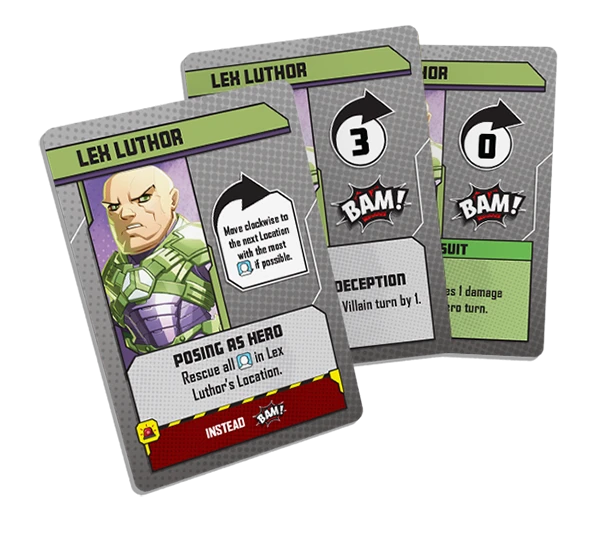
Lex Luthor’s gameplay emphasizes deception and strategic manipulation. Players must navigate his schemes and uncover his true intentions while dealing with the immediate threats he poses. Luthor’s ability to win by deceiving the heroes adds a layer of psychological warfare to the game, making him a challenging and engaging villain to face.
Innovative Villain Mechanics
Chiarvesio’s design philosophy for villains centers on deception and strategic complexity. DC villains are crafted to challenge heroes not just with brute strength but through cunning and trickery. Villains have unique BAM, Overflow, or Special effects that change based on their pressure status, adding twists and turns to the gameplay. This innovation keeps heroes on their toes and ensures dynamic, engaging encounters.

The design of the villains in “DC Super Heroes United” aims to reflect the depth and complexity of their comic book counterparts. Villains are not just obstacles to overcome but active participants in the narrative, each with their own goals and methods. This approach creates a richer and more immersive experience, where heroes must adapt their strategies to counter the evolving threats.
Teasing Future Content
Chiarvesio tantalizes fans with hints about other villains, including The Joker. Known for his chaotic plans, The Joker aims to poison everyone with his Joker Toxin, forcing heroes into a deadly shell game. Players must balance speed and caution to prevent The Joker from having the last laugh.

The Joker’s gameplay promises to be as unpredictable and dangerous as the character himself. His schemes will require players to think on their feet and adapt to rapidly changing circumstances. The Joker’s inclusion adds an element of chaos and unpredictability to the game, ensuring that every encounter with him is unique and challenging.
Conclusion
“DC Super Heroes United” promises to be a captivating blend of strategy, heroism, and villainy. Andrea Chiarvesio’s insights into the core box design highlight the meticulous thought process behind each character, ensuring an authentic and immersive experience for DC fans. The combination of strategic depth, character authenticity, and innovative mechanics makes “DC Super Heroes United” a highly anticipated addition to the United series.
At no extra cost to you, The Board Game Site may receive revenue from affiliate and advertising partnerships for sharing this content and from purchases through links.








